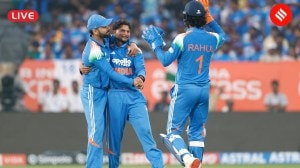What made Shyam Benegal’s films stand out?
Shyam Benegal is among the foremost directors of India’s Parallel Cinema wave. His films also challenged social norms and prized authentic portrayals of marginalised groups, at a time when films like ‘Sholay’ set the template for mainstream Hindi films.
 Director Shyam Benegal and actress Smita Patil. (Express archives)
Director Shyam Benegal and actress Smita Patil. (Express archives)The memorial of renowned filmmaker and writer Shyam Benegal was held Saturday evening (December 28) in Mumbai’s Y B Chavan Hall, honouring a legacy that included 24 feature films and more than 40 documentaries. Benegal passed away earlier this week in Mumbai, at the age of 90.
Among those present at the memorial were veteran actors Naseeruddin Shah and Shabana Azmi, who became the faces of the “New Indian Cinema” or “Parallel Cinema” wave that Benegal helped popularise through his films. He directed his first feature film Ankur (1974) and then six others in the 1970s, going against the grain at a time when larger-than-life films like Sholay and Deewar (both released in 1975) captivated audiences, and the idea of a larger-than-life “hero” was firmly established.
What are some characteristic elements of the auteur’s filmmaking and cinematography that led to him being recognised in a league of his own? We explain.
Authenticity in filmmaking
Gorvika Rao, a senior Assistant Professor at Miranda House, University of Delhi, says Benegal was inspired in part by Bengali cinema. Similar to arthouse filmmakers like Satyajit Ray and Ritwik Ghatak, who were already making films entirely different from mainstream Hindi movies in the 1950s and ’60s, Benegal tried to incorporate authenticity in his direction.
In her book Shyam Benegal, author and filmmaker Sangeeta Dutta highlights the filmmaker’s choice of using regional music “through his long-term collaborator Vanraj Bhatia.” Rao says that Benegal did not use songs in movies and in using folk songs, he followed the template of Bengali cinema.
The 1985 film Trikaal, set against the backdrop of a Goa under Portuguese control, uses Goan songs to show the culture authentically, she adds. Some of his earliest films were based on the anti-feudalism peasant movement in Telangana and were shot in real locations.
This authenticity was not limited to aesthetics. “Benegal focused on the raw struggles of the subaltern (those historically excluded from holding power and from mainstream society). This realism, coupled with stellar performances and social relevance, ensured both critical and commercial success,” author and film critic Abijit Radhakrishna says.
Spotlight on characters, not actors
In most of his films, Benegal did not play into the trope of a hero, ensuring that his actors become the characters. Rao says, “His idea was not to make a hero out of anyone, but to tell a story.” She adds that the director created a “Benegal universe” of sorts, where actors like Naseeruddin Shah, Shabana Azmi, Girish Karnad, and Om Puri (among others) appear often. However, in the larger scheme of things, their characters take centre stage rather than the actors themselves.
“For example, in Mandi (1983), you don’t remember the heroines… it’s the characters you remember,” Rao says. The film delved into the lives of women who worked in a brothel in Hyderabad.
Mandi also won the 1984 National Film Award for Best Art Direction. Dutta writes that in his movies, “….aesthetics were utilised to project the character with maximum impact – human beings were at the centre of the story, centre of the predicament.”
Social relevance
At their heart, Benegal’s movies brought forth issues pervading Indian society, at a time when cinema was seen as the most powerful medium to educate the masses and spread awareness. As such, his movies contributed significantly to the nation’s socio-cultural discourses, Radhakrishna says.
“Films like Arohan (1982) shed light on the plight of farmers, while Kalyug (1981) explored the moral and ethical dilemmas of capitalism. Like how the Italian Neorealist movement addressed the socio-economic realities of post-World War 2 Europe, Benegal’s work gave voice and agency to the marginalized and provoked a critical dialogue,” Radhakrishna adds.
With the films, Benegal sought to cover the broader spectrum of prevalent social challenges, rather than a few issues. “His cinema comes at the cusp of 25 years of Indian independence and the idea of Independence is that we have resolved all issues. But he is presenting you with cinema which critiques that,” Rao says.
Benegal displayed great versatility in showcasing India’s socio-political landscape. For instance, his first four movies all explored different themes. While Ankur deals with casteism and patriarchy, Nishant (1975) attempts a realistic portrayal of the rural elite and the sexual exploitation of women.
With his social critique in the films, Benegal said there is still some work to be done in the sphere of nation-building, Rao says. As late as the ’90s, films such as Mammo and Sardari Begum have such messaging. “Arthouse cinema was established with the idea that mainstream cinema is not raising issues and if they do, they take voyeuristic pleasure in showcasing them,” she adds.
Representation of women and the idea of morality
Throughout his filmography, Benegal tried to avoid commenting on the morality of the characters he put forth before the audience. “The idea of morality, which is typically linked with women, is not explored,” says Rao. In Mandi, the storyline is set against the backdrop of a brothel but there is no question of the women’s morality, she says.
“Even in movies like Ankur, Nishant and Bhumika (1977), he’s not questioning the women but the circumstances in a patriarchal society which force women to take certain actions,” Rao adds. In many of his movies, the women characters are headstrong. This is also reminiscent of Bengali cinema and novels, and the idea of strong and modern women was explored by Satyajit Ray and Rabindranath Tagore.
Dutta concurs that the women characters in his movies were never the “stereotypes as the archetypal mother or glamour object”, while also adding that the filmmaker always “excelled in exploring the female perspective”.
- 01
- 02
- 03
- 04
- 05






































